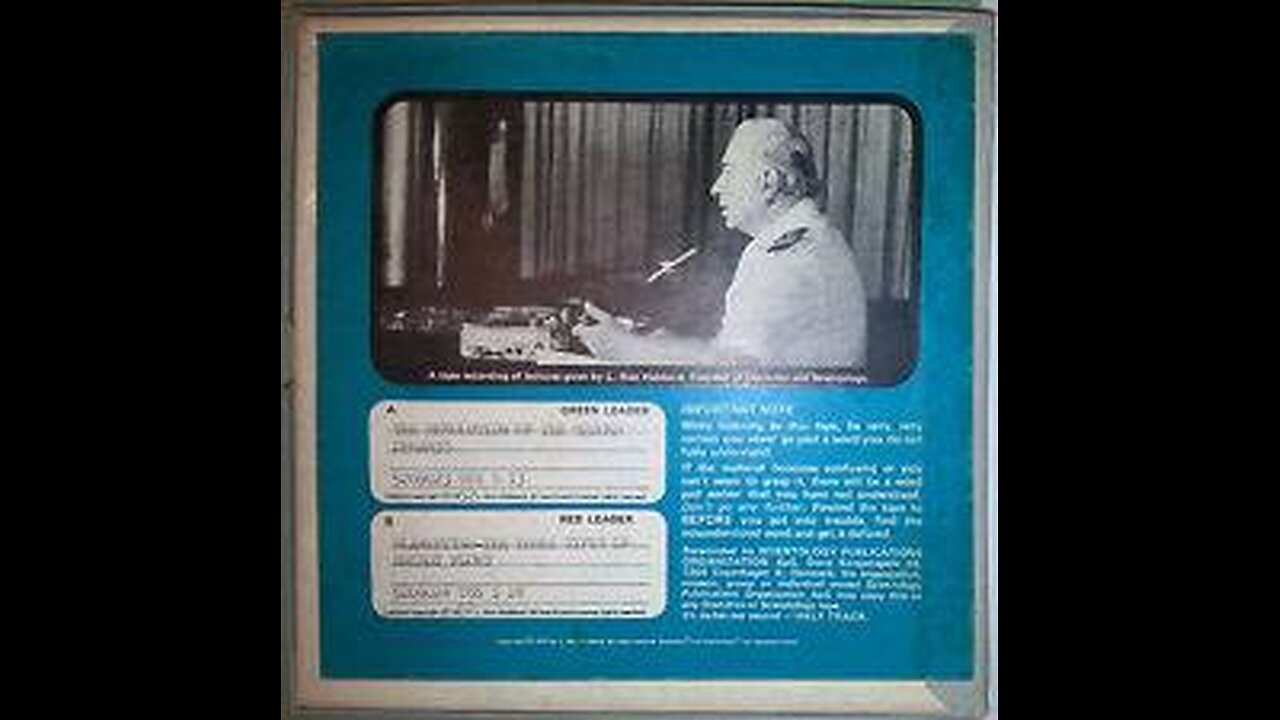Premium Only Content

Sandard Procedure Step Three: Holders Bouncers Deniers Psychotics
Main Points of the Lecture 5008c25
Emotional Discharge First
In auditing, the goal is to obtain an emotional release before moving deeper.
Minimal mechanical commands are best; too much force or repetition can bog down a case.
Freeing the Preclear on the Track
Many cases get stuck on the time track, causing poor perception or difficulty accessing incidents.
Methods include repeater techniques with deniers (“forget it,” “don’t think about it,” etc.), which can unstick attention without worsening the case.
Once free, the file clerk (mind’s automatic recall) and somatic strip (body recall mechanism) should begin functioning.
Standard Procedure Steps
Run painful emotion → test file clerk/somatic strip → seek earliest basic area incident.
If bogged, move to Step Three: Straightwire (memory recall techniques).
Never leave an engram half-run, as it can restimulate and worsen the preclear.
Running Engrams
Look for recurring key phrases (e.g., “I can’t feel”).
Reduce the earliest incident where the phrase appears rather than chasing later repetitions.
Locks (lighter incidents) can be used to “skip down” to deeper engrams.
Control Circuits & Valence Shifters
Step Three also addresses analytical “demons” (internalized critical commands) and valence shifters (identity switches, e.g., adopting parent’s or ally’s personality).
Running dramatizations (like a parent saying “control yourself”) can lead to the first time it occurred and unlock basic engrams.
Accessibility Problems
Some preclears resist lying down, refuse to be inventoried, or “bounce off the couch.”
These are considered accessibility issues — go to Step Three immediately rather than forcing them into reverie.
Straightwire Techniques
Coax the person into remembering small, safe things (e.g., walking into the room, their own name).
Expand gradually until memory flow opens.
This bypasses resistance and begins to unravel circuits and contagion of aberration (adopted phrases or attitudes from others).
Psychotic & Difficult Cases
Even psychotics can sometimes be audited by working patiently with repetition and straightwire.
The key is persistence and avoiding invalidating their data, no matter how incredible it sounds.
Overall Takeaway
Hubbard emphasizes that Step Three is the auditor’s fallback tool whenever the case won’t advance—whether due to stuck attention, refusal, or heavy control circuits. The auditor uses straightwire memory recall, deniers, and dramatization techniques to bypass resistance, locate engrams, and restore case progress.
-
 13:19
13:19
Degenerate Jay
15 hours agoThis Fallout: New Vegas Discovery Could Change Everything
120 -
 33:35
33:35
ArturRehi
18 hours agoNERVES OF STEEL - American Fighters Are not Easy to Frighten in Ukraine
261 -
 LIVE
LIVE
BEK TV
21 hours agoTrent Loos in the Morning - 12/03/2025
1,212 watching -
 LIVE
LIVE
The Bubba Army
20 hours agoTRUMP SAYS NO MORE INCOME TAX? - Bubba the Love Sponge® Show | 12/03/25
1,947 watching -
 LIVE
LIVE
FyrBorne
11 hours ago🔴Battlefield REDSEC Live M&K Gameplay: Testing Sleeper Loadouts
17 watching -
 28:54
28:54
ZeeeMedia
15 hours agoREAL ID Non-Compliance Fees from 2026 & WW3 Escalation | Daily Pulse Ep 154
5.49K28 -
 LIVE
LIVE
PudgeTV
2 hours ago🔴 Sea of Thieves - Gaming on Rumble | The Three Rumskateers Go Sailing Again!!
78 watching -
 LIVE
LIVE
Midnight In The Mountains™
21 minutes agoMorning Coffee w/ Midnight & The Early Birds of Rumble | Pudge Made me LATE! |
48 watching -
 LIVE
LIVE
Pickleball Now
4 hours agoLive: IPBL 2025 Day 3 | Nonstop Action from India’s Biggest Pickleball League
168 watching -
 1:12:46
1:12:46
MetatronGaming
1 day agoLet's Try Heroes of Might and Magic The Olden Era
22.7K2